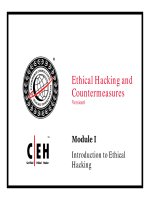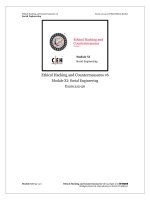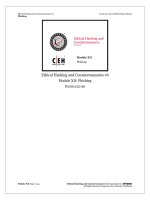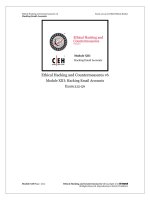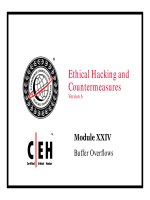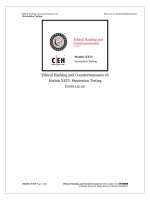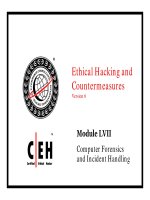Hands-On Ethical Hacking and Network Defense
Bạn đang xem bản rút gọn của tài liệu. Xem và tải ngay bản đầy đủ của tài liệu tại đây (1.04 MB, 51 trang )
HANDSON ETHICAL HACKING AND
NETWORK DEFENSE
Lesson 10
Hacking Web Servers
OBJECTIVES
Collection Information
Describe Web applications
Explain Web application vulnerabilities
Describe the tools used to attack Web servers
2
3
H
a
n
d
s
-
O
n
E
t
h
i
c
a
l
H
a
c
k
i
n
g
a
n
d
N
e
t
w
o
r
k
D
e
f
e
n
s
e
4
H
a
n
d
s
-
O
n
E
t
h
i
c
a
l
H
a
c
k
i
n
g
a
n
d
N
e
t
w
o
r
k
D
e
f
e
n
s
e
UNDERSTANDING WEB APPLICATIONS
It is nearly impossible to write a program without bugs
Some bugs create security vulnerabilities
Web applications also have bugs
Web applications have a larger user base than standalone
applications
Bugs are a bigger problem for Web applications
5
WEB APPLICATION COMPONENTS
Static Web pages
Created using HTML
Dynamic Web pages
Need special components
<form> tags
Common Gateway Interface (CGI)
Active Server Pages (ASP)
PHP
ColdFusion
Scripting languages
Database connectors
6
WEB FORMS
Use the <form> element or tag in an HTML document
Allows customer to submit information to the Web server
Web servers process information from a Web form by
using a Web application
Easy way for attackers to intercept data that users
submit to a Web server
7
WEB FORMS (CONTINUED)
Web form example
<html>
<body>
<form>
Enter your username:
<input type="text" name="username">
<br>
Enter your password:
<input type="text" name="password">
</form></body></html>
8
9
COMMON GATEWAY INTERFACE (CGI)
Handles moving data from a Web server to a Web
browser
The majority of dynamic Web pages are created with
CGI and scripting languages
Describes how a Web server passes data to a Web
browser
Relies on Perl or another scripting language to create
dynamic Web pages
CGI programs can be written in different
programming and scripting languages
10
COMMON GATEWAY INTERFACE (CGI)
(CONTINUED)
CGI example
Written in Perl
Hello.pl
Should be placed in the cgibin directory on the Web server
#!/usr/bin/perl
print "Content-type: text/html\n\n";
print "Hello Security Testers!";
11
ACTIVE SERVER PAGES (ASP)
With ASP, developers can display HTML documents to
users on the fly
Main difference from pure HTML pages
When a user requests a Web page, one is created at that time
ASP uses scripting languages such as JScript or
VBScript
Not all Web servers support ASP
12
13
ACTIVE SERVER PAGES (ASP)
(CONTINUED)
ASP example
<HTML>
<HEAD><TITLE> My First ASP Web Page </TITLE></HEAD>
<BODY>
<H1>Hello, security professionals</H1>
The time is <% = Time %>.
</BODY>
</HTML>
Microsoft does not want users to be able to view an
ASP Web page’s source code
This can create serious security problems
14
APACHE WEB SERVER
Tomcat Apache is another Web Server program
Tomcat Apache hosts anywhere from 50% to 60% of all
Web sites
Advantages
Works on just about any *NIX and Windows platform
It is free
Requires Java 2 Standard Runtime Environment (J2SE,
version 5.0)
15
16
17
USING SCRIPTING LANGUAGES
Dynamic Web pages can be developed using scripting
languages
VBScript
JavaScript
PHP
18
PHP: HYPERTEXT PROCESSOR (PHP)
Enables Web developers to create dynamic Web pages
Similar to ASP
Opensource serverside scripting language
Can be embedded in an HTML Web page using PHP tags <?
php and ?>
Users cannot see PHP code on their Web browser
Used primarily on UNIX systems
Also supported on Macintosh and Microsoft platforms
19
PHP: HYPERTEXT PROCESSOR (PHP)
(CONTINUED)
PHP example
<html>
<head>
<title>My First PHP Program </title>
</head>
<body>
<?php echo '<h1>Hello, Security Testers!</h1>'; ?>
</body>
</html>
As a security tester you should look for PHP
vulnerabilities
20
21
CONNECTING TO DATABASES
Web pages can display information stored on
databases
There are several technologies used to connect
databases with Web applications
Technology depends on the OS used
ODBC
OLE DB
ADO
Theory is the same
22
OPEN DATABASE CONNECTIVITY
(ODBC)
Standard database access method developed by
the SQL Access Group
ODBC interface allows an application to access
Data stored in a database management system
Any system that understands and can issue ODBC
commands
Interoperability among backend DBMS is a key
feature of the ODBC interface
23
OPEN DATABASE CONNECTIVITY
(ODBC) (CONTINUED)
ODBC defines
Standardized representation of data types
A library of ODBC functions
Standard methods of connecting to and logging on to a
DBMS
24
OBJECT LINKING AND EMBEDDING
DATABASE (OLE DB)
OLE DB is a set of interfaces
Enables applications to access data stored in a DBMS
Developed by Microsoft
Designed to be faster, more efficient, and more stable
than ODBC
OLE DB relies on connection strings
Different providers can be used with OLE DB
depending on the DBMS to which you want to
connect
25

